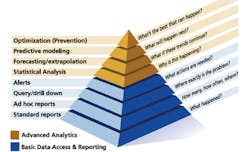Advanced and Predictive Analytics in Safety: Are They Worth The Investment?
Are workplace safety software systems that employ advanced and predictive analytics worth the investment?
Most managers from other business functions would say "absolutely!" That's because advanced and predictive analytics systems have been delivering huge returns on investment (ROI) in fields like marketing, sales, supply chain and operations for years. A quick Web search reveals countless examples of advanced and predictive analytics being used to improve business functions across various industries:
➠ A tea and coffee retailer saw a 310 percent increase in revenue, a 665 percent increase in ROI for their marketing campaigns and a cost-per -click reduction to about one-third of previous levels.
➠ A specialty bio-agronomic products company was able to increase visibility into supply chain operations and provide marketing, sales and operational users with better information for planning and decision making, resulting in a 383 percent ROI in just 4 months with an annual benefit of around $1 million.
➠ A provider of personal, nonstandard automobile insurance achieved a 403 percent ROI in just 3 months by reducing claims payments and accelerating the collection of subrogation payments.
Predictive Analytics and Safety
Similar advanced and predictive analytics software systems have been deployed across safety functions with dramatic results. It statistically has been proven, using 4 years of real-world safety data, that workplace injuries can be predicted with accuracy rates as high as 97 percent. It also has been proven across numerous companies that if injuries can be predicted, they can be prevented – here are some examples:
➠ A Fortune 150 energy company reduced its injury rate by 67 percent within 18 months.
➠ A Fortune 150 manufacturer reduced its lost workday rate by 97 percent within 1 year.
➠ A top 20 construction company achieved significant safety improvements including 90 percent of worksites experiencing no lost-time incidents.
But how can a company determine if it will get similar results and positive ROI on investment in similar solutions? You can start by answering these three questions: First, what are you trying to accomplish? Second, is your organization ready? And third, how will you measure success?
In order to determine if advanced and predictive analytics systems are right for your organization, you first need to decide what you're trying to accomplish with their use. What questions are you trying to answer? The above graphic, adapted from the book Competing on Analytics: The New Science of Winning by Thomas Davenport and Jeanne Harris, shows the different questions that can be addressed by various levels of reporting and analytics.
If all you are trying to do is gain access to and report on your historic data, then a basic data access and reporting solution is sufficient. Such a solution is great for reporting out to various stakeholders within your company and answering basic questions about what is going on across your company and how you are doing in complying with various standard operating procedures, regulations, etc.
However, if you want to start answering deeper questions such as, "Where and when will injuries happen next?" and "How do I optimize my response to these injury risks so I can prevent them?," then you need the advanced and predictive analytics functionality represented in the gold section near the top of the pyramid in the graphic above. There is little doubt that solutions that include this advanced functionality will be more expensive, but if your company or facility is able to achieve the dramatic results previously mentioned, this added investment will be well worth it.
Are You Ready?
Many companies have wrung most, if not all, of the value possible out of traditional safety improvement methods – things like root cause analyses of injuries, safety training and awareness programs; a human- or behavior-based focus; job safety assessments; and even safety consulting engagements. As a result, many of these companies have plateaued in their ability to reduce their injury rates.
How can companies achieve dramatic, positive workplace safety results? Rather than rely on old, tired andAn organization must be prepared to deploy such solutions. First, it has to be committed to collecting data. This often means that leadership and management must support some amount of their frontline work force's participation in safety data collection, usually in the form of safety observations. Many companies find this investment to be well worth it, especially since advancements in mobile computing technology and paper scanning technology have reduced the costs of data collection tremendously.
Next, leadership and management must be ready to take action on the results of the advanced and predictive analytics. Here's a true story of an organization that was NOT ready to take this step initially. A division of a Fortune 150 manufacturer deployed predictive analytics across its 10 locations. The system "red-flagged" four of these 10 locations as having a high likelihood of increased injuries over the next 30 days. The division ignored the flags and three of the four sites had injuries within the next 30 days, as the software had predicted.
Now, the safety director instituted an intervention process that occurs each time the system flags a location. Though it is early in the implementation of this process, one of its sister divisions implemented a similar process and reduced safety incidents by more than 90 percent in just 18 months.
If leadership is committed to creating the space for its frontline workers to collect the necessary data, and to take action once that data is analyzed and predictions are made, then your organization is ready to deploy advanced and predictive analytics. But before you proceed, you should consider the final question.
How Will We Measure Success?
If you – or more importantly, your manager, CEO, board of directors, etc. – are demanding a quantifiable ROI on any investment in advanced and predictive analytics in safety, then you must consider how you'll measure success before you start. Some measures of success that are used are as follows:
➠ Reduction of incidents and incident rates (and thus lower costs).
➠ Reduction of direct workers' compensation or other insurance fees or other insurance measures such as an experience modification rate (EMR).
➠ Automation of time spent manually "crunching numbers" and analyzing data.
➠ Automation of time spent manually collecting data.
➠ Improved safety culture measures.
➠ Other tangential benefits (many companies find their quality and productivity measures improve as safety measures improve).
While the cost of even the most robust advanced and predictive analytics generally is measured only in thousands of dollars, the benefits are measured in the millions, for example:
➠ A top 5 public U.S. university saved over $20 million in insurance fees across 4 years of building projects.
➠ A top 5 U.S. general contractor saved over $9.5 million per year through injury reduction.
➠ A large electrical contractor and system integrator reduced its workers' compensation rates by 57 percent and 66 percent 2 years in a row while man hours were increasing.
➠ A global insurance company reduced its manual data collection, analytics and report-writing time by 22 percent, allowing their risk managers to focus on more strategic items of interest to their customers.
A diverse set of company stakeholders are demanding better results each and every year across all aspects of their business – including safety. Now that advanced and predictive analytics are both proven and pervasive in other business functions, it is much easier to make the case to employ them in safety. However, companies should determine how they will be used, if their organization is ready and how they will measure their success before they proceed.
Griffin Schultz is the general manager of Predictive Solutions, an Industrial Scientific company. Predictive Solutions predicts workplace injuries so their customers can prevent them. He can be reached at [email protected].

